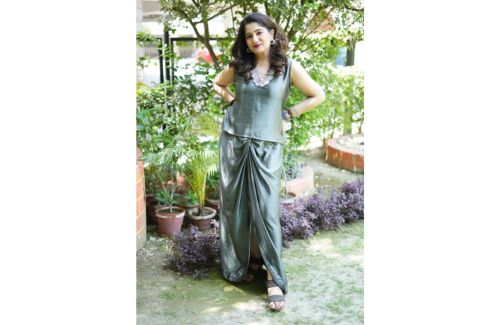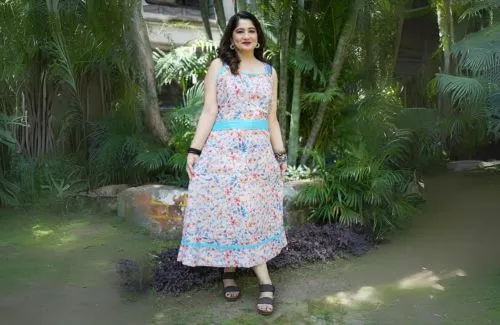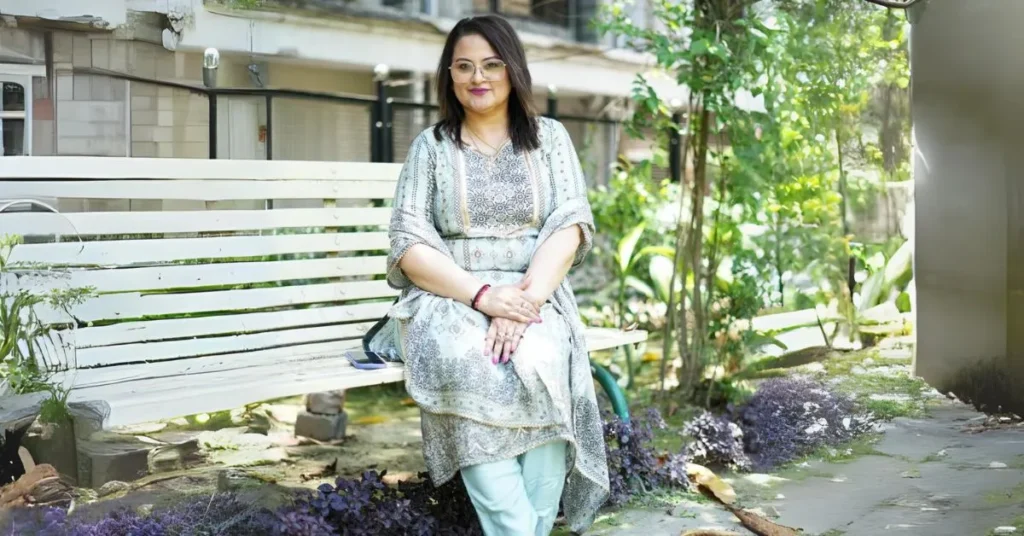In this exclusive interview, we delve into the inspiring journey of a trailblazing fashion designer who has redefined the industry with her commitment to inclusivity, innovation, and sustainability. From overcoming initial resistance to plus-size fashion to integrating cutting-edge technology in her design process, she shares her philosophy, challenges, and the driving force behind her unique creations.
Poulami: Can you share with us how you got started in the garment business and what inspired you to create your own design pieces?
AB: Ten years ago, my odyssey commenced, propelled by my conscience, aptitude, and creativity, steering me steadfastly toward my aspirations. Among these goals, achieving self-reliance held paramount significance. Throughout, my affection for sketches and the arts remained unwavering. I reveled in the harmonious dance of colors melding into one another, birthing creations of breathtaking beauty.
Poulami: How would you describe your design philosophy and what key elements make your pieces unique in the fashion industry?
AB: My philosophy is straightforward: I understand my audience, and frankly, size zero isn’t my focus. My designs transcend specific demographics, appealing to those who appreciate clothing and view fashion as wearable comfort. I fail to comprehend creating garments for an audience that merely observes clothes rather than envisioning wearing them. True elegance is achieved when an item beckons to be purchased and possessed. We have embraced change and understand our customers intimately. Personally, I have always embraced crafting dresses for all sizes!

Poulami: What are some of the biggest challenges you’ve faced as a businesswoman in the garment industry, and how have you overcome them?
AB: One of the most significant challenges I encountered in the garment industry was the initial resistance I faced when venturing into plus-size fashion. There were countless skeptical glances directed my way, as society had long dictated that women should conform to a particular size. However, I persevered, designing clothes for women in their mid-40s and 50s, drawing inspiration from the iconic styles of the 80s and 90s.
Poulami: How do you stay updated with the latest fashion trends, and how do these trends influence your designs?
AB: Fashion is perpetually evolving, with trends circling back into vogue; even bell bottoms are making a comeback. In my recent endeavor, I resurrected Hema Malini’s iconic outfits, reviving the timeless charm of polka dots. Collaborating as the costume designer for a film directed by Paramita Munsi, I infused my creations with an Indo-fusion aesthetic. Whether it’s pairing a skirt with a traditional jacket or embellishing a sequined top with a jhoti skirt, I strive to marry tradition with contemporary flair in my designs.
Poulami: In an era where sustainability is becoming increasingly important, how do you incorporate sustainable practices into your business and designs?
AB: I am all about mixing and matching. I recall a time when I transformed an entire saree into a stunning dress. My approach to fashion is about extracting the beauty from anything at hand and elevating it into a statement piece. That’s my definition of true fashion ingenuity.
Poulami: How do you gather and incorporate customer feedback into your design process to ensure your pieces meet their expectations?
AB: Understanding my clients is paramount to me. Take Aparajeeta Adhya, for example; I am well aware of her vibrant personality, so I chose a black ensemble with sequins, perfectly complementing her energy, which she wore at an event. Similarly, for Indroneel Mukherjee, I aimed for something cool yet fashionable, aligning seamlessly with his persona. Personalization is key in ensuring that my designs resonate with each individual client.

Poulami: What marketing strategies have you found to be the most effective in promoting your brand and attracting customers?
AB: Word of mouth has always been my go-to marketing strategy. I rely on the power of personal recommendations and satisfied clients to spread the word about my work. There’s no better endorsement than a happy customer sharing their positive experience with others.
Poulami: How has technology impacted your design and production processes, and what innovations are you most excited about?
AB: Technology has revolutionized our design and production processes in numerous ways. From streamlining workflows to enhancing creativity, its impact has been profound. CAD software, for instance, has facilitated the design phase, allowing for quicker iterations and precise detailing. Additionally, advanced manufacturing techniques like 3D printing have opened up new possibilities for prototyping and customization.
One innovation that particularly excites me is the integration of artificial intelligence (AI) in fashion design. AI-powered tools can analyze vast amounts of data, including consumer preferences and market trends, to inform design decisions. This not only helps in creating more tailored and relevant designs but also improves forecasting accuracy, reducing waste and optimizing inventory management.
Furthermore, sustainable practices facilitated by technology are another area of interest. From using recycled materials to implementing eco-friendly production processes, technology enables us to minimize our environmental footprint while still delivering high-quality products.
Also Read: Woman Times June Edition 2024
Overall, the fusion of technology with fashion holds immense potential for driving innovation, improving efficiency, and advancing sustainability in the industry. As a designer, I am eager to continue exploring and embracing these advancements to enhance my creative process and deliver value to my customers.
Poulami: What are your future plans for your business? Are there any new projects or collaborations on the horizon that you can share with us?
AB: I want to plan it across pan India.
Poulami: What advice would you give to aspiring fashion designers who wish to start their own garment business and create their own design pieces?
AB: AI would advise them to prioritize understanding their audience first and foremost. It is crucial to comprehend the preferences and desires of your target demographic before creating garments. Tailoring your designs to suit the tastes of your audience ensures that your creations resonate with them, increasing the likelihood of success in the market.




2 Responses